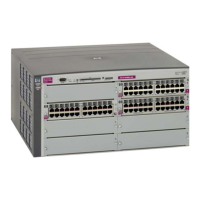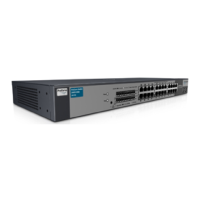Configuring the switch 127
The switch software image is the executable code running on the switch. A version of the image ships with the
switch, and comes pre-installed on the device. As new versions of the image are released, you can upgrade the
software running on your switch.
Upgrading the software image on your switch requires the following:
• Loading the new image onto a TFTP server on your network
• Downloading the new image from the TFTP server to your switch
• Selecting the new software image to be loaded into switch memory the next time the switch is reset
Downloading new software to your switch
The switch can store up to two different software images, called image1 and image2, as well as boot
software, called boot. When you download new software, you must specify where it should be placed: either
into image1, image2, or boot.
For example, if your active image is currently loaded into image1, you would probably load the new image
software into image2. This lets you test the new software and reload the original active image (stored in
image1), if needed.
To download new software to your switch, you will need the following:
• The image or boot software loaded on a TFTP server on your network
• The hostname or IP address of the TFTP server
• The name of the new software image or boot file
Configuration
When you make configuration changes to the switch, you must save the changes so that they are retained
beyond the next time the switch is reset. When you perform the save command, you have two save options:
save and save n. With save, your new configuration changes are placed in the active configuration block. The
previous configuration is copied into the backup configuration block. If you select save n, your new configuration
changes are placed in the active configuration block, and the backup configuration block remains unchanged.
There is also a factory configuration block. This holds the default configuration set by the factory when your
switch was manufactured. Under certain circumstances, it may be desirable to reset the switch configuration to
the default. This can be useful when a custom-configured switch is moved to a network environment where it will
be re configured for a different purpose.
Switch Image and Configuration Management controls
The following table describes Switch Image and Configuration Management controls:
Table 98 Switch Image and Configuration Management controls
Control Description
Image 1 Version Displays information about the current Image 1 software.
Image 2 Version Displays information about the current Image 2 software.
Boot Version Displays the version number of the current Boot software.
Active Image Version Displays the version number of the active software image.
Next Boot Image Selection Selects which software image (image1 or image2) you want to run in
switch memory for the next reboot.
Active Configuration Block Displays the Configuration Block file that is currently running (active or
backup).
Next Boot Configuration Block Selection Selects the Configuration Block file (active or backup) that will run after the
next reboot.
Next CLI Boot Mode Selection Selects the type of command-line interface (CLI) used after the next reboot.
TFTP Settings
Hostname or IP Address of TFTP server Enter the host name or IP address of the TFPT server from which you will
download software.
Image Settings
Image for Transfer Selects a software image to replace with the downloaded software.

